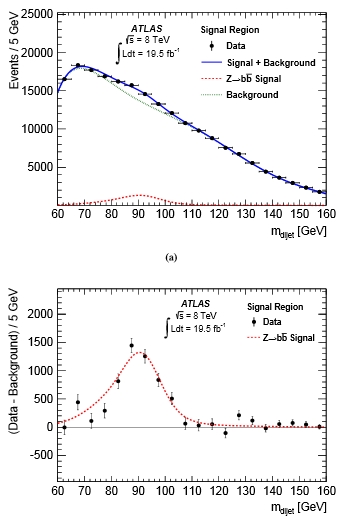The signal is the decay of the Z boson into pairs of b-quarks. The Z boson decays that way 15% of the time, and 55% more into other quark-antiquark pairs. B quarks are different from all others in that they can be distinguished by the way they hadronize: they produce a bottom hadron, which decays after 1.5 picoseconds leaving a distinguishable signal in the detector.
Wait - I can hear some say - isn't the Z boson decay to b-quark pairs a subject studied in excruciating detail already, by the LEP experiments ? What is the business here ?
Well, as I said at the beginning, there is no surprise nor any groundbreaking new measurement involved. The Z boson is indeed one of the most well-studied elementary particles we know (okay the electron and the muon are known a little better, but allow me this stretch).
The fact is that at a hadron collider Z boson decays involving only quark final states are extremely hard to extract, so the feat of ATLAS is interesting in its own right. But of course there is more. The Z->bb signal was observed (by yours truly) in CDF data in 1998 for the first time in hadron collisions, and ten years after we managed to measure the b-jet energy scale by determining carefully the peak position of 4000 such decays. Yet at the LHC this had not been done before, and ATLAS did it in a very special way - by looking for pairs of boosted b-quarks.
Boosted topologies of jets from hadronically-decaying resonances are becoming a very effective way to search for new physics. Until now the top quark had been shown to be reconstructable from "fat jets" which contained three "sub-jets" each produced by the independent hadronization of one of the three decay products of top quarks; this of course also involved finding the two sub-jets due to the W boson decay. But the Z boson had not been seen yet.
ATLAS did not search for a single fat jet of very high momentum; they found the Z->bb signal in events with three jets, two of them close in angle but separated enough to be independently reconstructed and b-tagged. The selection, besides b-tagging, involved using two kinematical variables capable of separating, on a statistical basis, the signal of Z->bb recoiling against a third jet from all QCD background processes yielding three jets. The latter include gluon-gluon production when one of the gluons "splits" into a pair of b-quark jets.
 The graph on the right shows the dijet mass distribution extracted by ATLAS in their "signal-rich" dataset (from 20 inverse femtobarns of pp collisions at 8 TeV collected in 2012). The shoulder around 90 GeV is indeed due to the Z signal (also shown as a dashed red line at the bottom, and in the lower panel as a background-subtracted distribution). Such a signal can be used to prove the techniques of evidencing the Higgs decay to b-quark pairs, and also to calibrate the b-jet energy scale.
The graph on the right shows the dijet mass distribution extracted by ATLAS in their "signal-rich" dataset (from 20 inverse femtobarns of pp collisions at 8 TeV collected in 2012). The shoulder around 90 GeV is indeed due to the Z signal (also shown as a dashed red line at the bottom, and in the lower panel as a background-subtracted distribution). Such a signal can be used to prove the techniques of evidencing the Higgs decay to b-quark pairs, and also to calibrate the b-jet energy scale.
The b-jet energy scale is a factor (close to 1.0) which accounts for any possible difference between the energy with which a jet of some fixed transverse energy -say 50 GeV- is reconstructed in real data and in simulation. Imagine a 50 GeV jet results in your estimate of 45 GeV: you are annoyingly off by 10%, and yet this would not be too bad if your simulation accounted for it. For imagine that a simulated 50 GeV jet is also on average reconstructed as a 45 GeV one: then there is no mismatch between data and Monte Carlo, and you can still measure, e.g., the invariant mass of the top quark by comparing the mass distribution of real data with different distributions obtained by simulations which assumed different values for the top mass. Both real and simulated jets are underestimated by 10%, but your top mass will come out right anyway. If, however, a simulated 50 GeV jet were measured to be 50 GeV, then we would have a problem: we would need to correct our jets up 10% (well, by 50/45), in order to be able to use the jets in a mass measurement.
The jet-energy scale is a factor which is very carefully determined by experiments that do jet spectroscopy, and in particular for the precise top quark mass measurements. B-quark jets are different from generic jets, however, and their specific jet energy scale is harder to determine. Hence the importance of a "calibration line" for b-quark pairs, the Z->bb signal. At least, theoretically.
On this latter issue I have a small critique to make to the ATLAS collaboration. While in fact they cite the work of the group of CDF researchers who determined the b-jet energy scale from Z->bb events in 2008 (J. Donini et al, NIM A596 (2008)354 -yes I am in the author list too), they say we "proposed" to measure the scale, while we in fact MEASURED it (our paper found 0.974+0.020-0.018).
So, ATLAS colleagues, please revise the text of your paper before you submit it for publication ! Thank you very much for citing us anyway, and well done finding the Z !




Comments